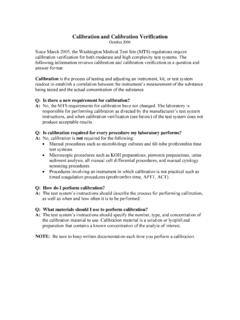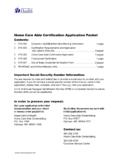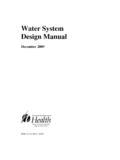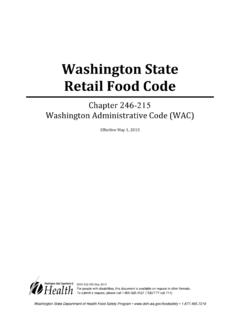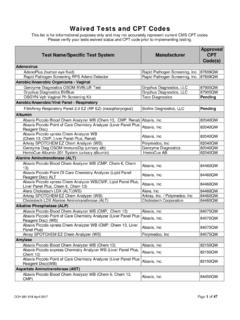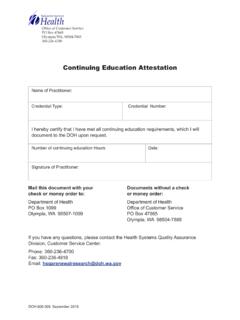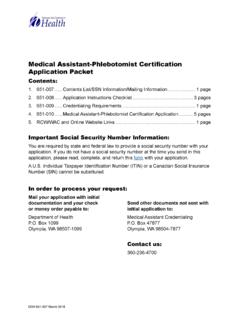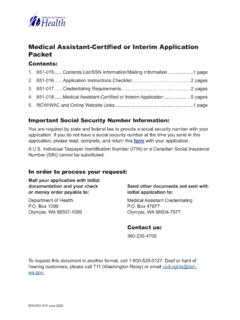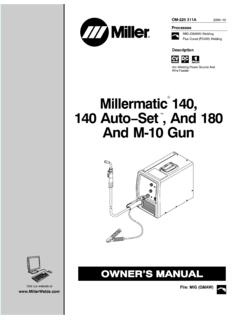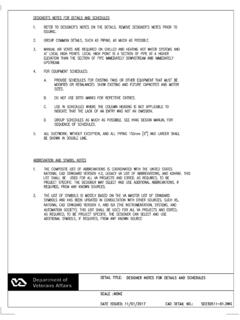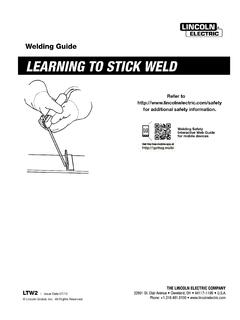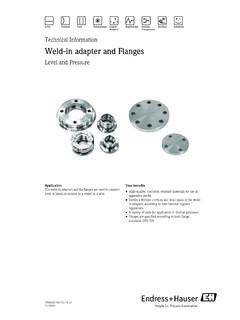Transcription of How to handle chlorine gas safely
1 1 May 2010 DOH 331-364 How to handle chlorine Gas safely Exposure to chlorine is irritating to the eyes, nose, throat, and mucous membranes. At high levels, exposure could cause serious injury or death. chlorine gas is greenish-yellow and smells like bleach. It is highly corrosive and reacts violently with petroleum products such as gasoline, diesel, oil, solvents, and turpentine. chlorine can also react with carbon monoxide and other combustion products to make highly toxic and corrosive gases. chlorine gas weighs about times more than air and will settle in low-lying areas unless there is sufficient wind to disperse it.
2 Despite these hazards, proper training can help reduce the risk for those who handle it. This publication is not a substitute for formal training. It does discuss chlorine handling and safety practices, especially for small water systems. Emergency Help Make a list of all relevant contact numbers and keep it posted at several locations in the plant and office (See page 4). Be sure to include the fire department that will respond to your facility, police department, county emergency management office, and your Department of Health Office of Drinking Water regional office.
3 This list will be particularly important if you don t have 9-1-1 service in your area. Keep the numbers updated. Inform local police and fire departments about the chemicals used in your plant, especially chlorine , so they can be prepared if an emergency occurs. You should organize escape plans from areas where there might be a chlorine release. Taking short cuts could be deadly. Protective equipment for water systems that use chlorine gas Respiratory equipment where employees handle chlorine : Your equipment should meet National Institute for Occupational Safety and Health requirements.
4 It should use compressed air, have at least a 30-minute capacity, and be: Available where employees handle chlorine gas. Kept in a convenient location, but not inside any room where chlorine is used or stored. Compatible with or identical to the units your fire department uses. Tested and refilled regularly. Ask your fire department to inspect and test the unit(s). -2-Other equipment: Each operator should have rubber gloves, a protective apron or other protective clothing, and goggles or a facemask. A deluge shower and eye washing station where operators use or store strong acids or alkalis.
5 Provide warm water for the shower. The Buddy System It s wise to have a second person present when you change or handle chlorine . If one operator is incapacitated, the other can call for help. Do not work alone! Separate chlorine Room It s important to have a separate room for chlorine gas. Check with local building officials, the fire marshal, and the chlorine Institute about safe storage and use requirements for chlorine . The chlorine storage and feed rooms should be: ; Enclosed, sealed, and separated from other operating areas. ; On the downwind side of the building, away from entrances, windows, louvers, walkways, and other occupied areas.
6 ; At least 60 F, but protected from extreme heat or direct sunlight. The room should have: ; A shatter-resistant inspection window mounted in an interior wall of the plant. ; Doors equipped with panic hardware that provide an easy escape by opening outward to the building exterior. ; A ventilating fan that exchanges the air at least once a minute. Run the fan whenever the room is occupied. ; An air intake near the ceiling and an exhaust near the floor. Make sure the fan exhausts outdoors and moves air as far as possible away from doors, air inlets, or occupied areas.
7 ; Motorized louvers that provide airtight closure. ; Individual vandal-proof switches for the fan and lights located both outside the chlorine room and at the inspection window. Provide signal lights if you can control the fan from more than one location. ; A nonslip floor. Floor drains are a bad idea. If your chlorine room does have a floor drain, seal it or make sure it discharges outdoors away from air inlets, doors, or occupied areas. The drain should not connect to other internal or external drainage systems. chlorine Leak Detection The chlorine room should have continuous leak-detection equipment with audible and visual alarms employees throughout the treatment plant can see and hear.
8 Follow the manufacturer s recommendation for calibrating and testing the equipment. Record your findings. You can use a rag soaked in concentrated ammonia solution to locate gas leaks at fittings and pipe connections. A white cloud or vapor indicates a leak. Make sure workers have a chlorine Institute-approved leak repair kit (Kit A for cylinders and Kit B for containers). -3-Safety Tips for 100- and 150-Pound Cylinders and Ton Containers Take shallow breaths in the chlorine room until you are sure there is no chlorine leak. Never lift a cylinder by its hood.
9 Always keep the hood in place, except when the cylinder is in use. Never expose a cylinder to heat or direct sunlight. Never drop a cylinder, or knock a cylinder over. Always keep empty cylinders separate from full ones. Always secure empty and full cylinders with a cable or chain. Never tamper with a fusible plug. Never store chlorine with ammonia. Don t move full ton containers with equipment designed to handle less than two tons. Don t connect liquid valves of two or more containers to a common manifold. Never store combustible or flammable materials near chlorine containers.
10 Never attempt to weld an empty chlorine pipeline without purging it with air. Don t spray water on a leaking container. It will make the leak worse. Changing 100- and 150-Pound Cylinders 1. Turn valve stem clockwise to close cylinder valve. 2. Allow float in flow meter to drop to zero. Indicator on front of gas feeder should indicate no gas. 3. Wait about one minute. Float should remain at zero. If the float flutters or does not drop to zero, the valve is not closed tightly. Make sure the valve is closed before proceeding. 4. Turn off ejector, and make certain the gas supply indicator stays in the No Gas position by turning the Reset knob.
